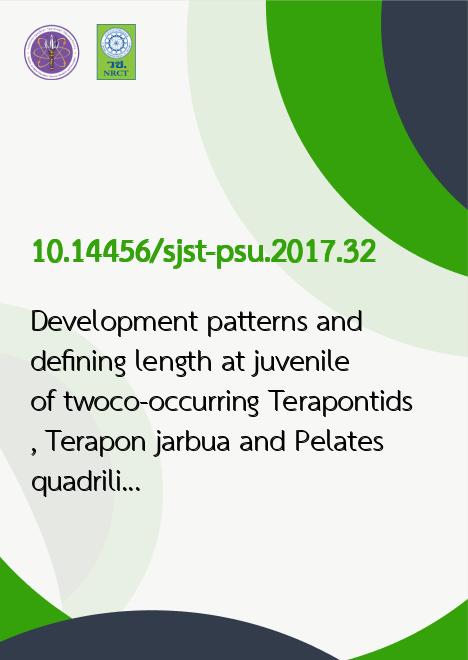
|
Development patterns and defining length at juvenile of twoco-occurring Terapontids, Terapon jarbua and Pelates quadrilineatus,from Trang province coastal area, Southern Thailand |
|---|---|
| รหัสดีโอไอ | |
| Creator | 1. Nuengruetai Yoknoi 2. Jes Kettratad 3. Nittharatana Paphavasit 4. Prasert Tongnunui |
| Title | Development patterns and defining length at juvenile of twoco-occurring Terapontids, Terapon jarbua and Pelates quadrilineatus,from Trang province coastal area, Southern Thailand |
| Publisher | Research and Development Office, Prince of Songkla University |
| Publication Year | 2560 |
| Journal Title | Songklanakarin Journal of Science and Technology (SJST) |
| Journal Vol. | 39 |
| Journal No. | 3 |
| Page no. | 293 |
| Keyword | coexist adaptation,larvae,juvenile,morphology,terapontids |
| ISSN | 0125-3395 |
| Abstract | This study aimed to describe development patterns and define length at juvenile of two co-occurring terapontidfishes. Terapon jarbua (n=366, 1.49-48.24 mm) and Pelates quadrilineatus (n=314, 1.64-54.13 mm) were collected from coastalarea, Trang Province, Thailand. Specimens were divided into five developmental stages: preflexion larvae, flexion larvae,postflexion larvae, transforming larvae, and juvenile by study of morphometric character, meristic character and pigmentationpattern. The length at juvenile was defined by using a multivariate analysis of morphometric characters. The length at juvenilestage of T. jarbua and P. quadrilineatus began at 23.16 mm and 18.24 mm in standard length, respectively. All morphometriccharacters were significantly different (P<0.05) between transforming larvae and juvenile stage in both species. An understandingin development patterns can aid in the explanation of their ontogenetic niche shifts. Due to the actual timing ofswitches in diet and habitat, it usually relates to changes in morphology of fish. The increase of mouth and jaw were significantin the ontogenetic dietary shift. The increase of body depth, fin length and eye size were also important to the mobileability and feeding habitat shift in terapontid fishes. |
